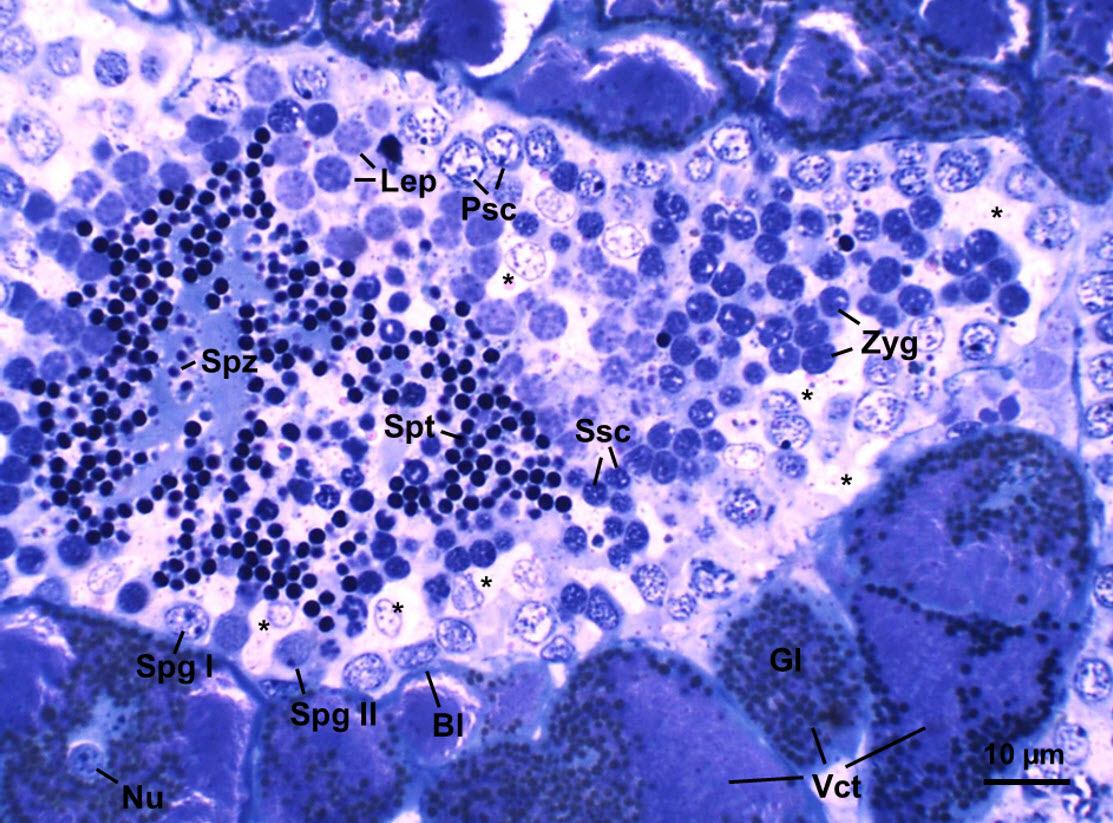การเจริญของอวัยวะสืบพันธุ์เพศผู้และการสร้างเซลล์สืบพันธุ์เพศผู้ในหอยนางรมปากจีบ Saccostrea cucullata (Born, 1778)
Main Article Content
Abstract
Rattanachat Khiusakunkan, Kullanist Thanomjit, Supatta Chueycham and Sutin Kingtong
รับบทความ: 31 กรกฎาคม 2560; ยอมรับตีพิมพ์: 18 กันยายน 2560
บทคัดย่อ
หอยนางรมเป็นสัตว์ที่มีเพศแยก ปัจจุบันพบรายงานการศึกษาการเจริญของอวัยวะสืบพันธุ์เพศผู้และการสร้างเซลล์สืบพันธุ์ในหอยนางรมหลายชนิด แต่ยังไม่มีการรายงานในหอยนางรมปากจีบ Saccostrea cucullata (Born, 1778) ซึ่งเป็นหอยนางรมที่เพาะเลี้ยงมากในภาคตะวันออกของประเทศไทย งานวิจัยนี้มีวัตถุประสงค์เพื่อศึกษาระยะการเจริญของอวัยวะสืบพันธุ์และการสร้างเซลล์สืบพันธุ์เพศผู้ในหอยนางรมปากจีบที่เก็บจากพื้นที่เพาะเลี้ยงบริเวณชายฝั่งจังหวัดชลบุรี โดยเตรียมตัวอย่างเนื้อเยื่อด้วยวิธีฝังในพาราฟินและเรซินเพื่อตัดเนื้อเยื่อให้บางและย้อมสี จากนั้นนำมาศึกษาด้วยกล้องจุลทรรศน์แบบใช้แสง ผลการศึกษาพบว่าอวัยวะสืบพันธุ์ของหอยนางรมปากจีบเริ่มพัฒนาในบริเวณเนื้อเยื่อเกี่ยวพันที่อยู่ระหว่างเนื้อเยื่อแมนเทิลและต่อมสร้างน้ำย่อย อวัยวะสืบพันธุ์ประกอบ ด้วยท่อสร้างเซลล์สืบพันธุ์จำนวนมากเชื่อมต่อกัน และมี vesicular connective tissue cell ล้อมรอบ สามารถแบ่งระยะการเจริญของอวัยวะสืบพันธุ์เพศผู้ในหอยนางรมปากจีบออกเป็น 5 ระยะ ตามระยะการเจริญของเซลล์สืบพันธุ์ที่อยู่ภายในท่อ ได้แก่ ระยะที่ 1 ระยะที่ไม่สามารถระบุเพศได้ ระยะที่ 2 ระยะเริ่มพัฒนาเซลล์สืบพันธุ์เพศผู้ ระยะที่ 3 ระยะพัฒนาเซลล์สืบพันธุ์เพศผู้ตอนปลาย ระยะที่ 4 ระยะเซลล์สืบพันธุ์เพศผู้พัฒนาสมบูรณ์ และระยะที่ 5 ระยะปล่อยเซลล์สืบพันธุ์ ภายในท่อสร้างเซลล์สืบพันธุ์พบเซลล์สืบพันธุ์ระยะต่าง ๆ ได้แก่ สเปอร์มาโทโกเนียม สเปอร์มาโทไซต์ระยะแรก สเปอร์มาโทไซต์ระยะที่สอง อยู่ใกล้กับด้านฐานของท่อสร้างเซลล์สืบพันธุ์ พบสเปอร์มาทิดและอสุจิอยู่กลางท่อ นอกจากเซลล์สืบพันธุ์ที่พบในระยะต่าง ๆ แล้ว การศึกษาในครั้งนี้ยังพบเซลล์ค้ำจุนในหอยนางรมปากจีบซึ่งเป็นรายงานการพบระบบเซลล์ค้ำจุนในท่อสร้างเซลล์สืบพันธุ์เพศผู้เป็นครั้งแรกในหอยนางรมสกุล Saccostrea สันนิษฐานว่าทำหน้าที่คล้ายกับเซลล์เซอโทไลของสัตว์มีกระดูกสันหลัง
คำสำคัญ: หอยนางรม การสร้างเซลล์สืบพันธุ์เพศผู้ เซลล์ค้ำจุนในท่อสร้างเซลล์สืบพันธุ์ อวัยวะสืบพันธุ์
Abstract
Oysters are dioecious with separate sexes. Currently, oyster spermatogenesis has been reported in many species. However, no evidence has been reported in the hooded oyster Saccostrea cucullata (Born, 1778) which is an important cultivated species along the Gulf of Thailand. In this work, male gonad development and spermatogenesis had been investigated in the hooded oyster collected from oyster farm in Chonburi coastal water. The collected oysters were embedded in both paraffin and resin in order to process and stain thin tissues to be able to observe under a light microscope. The results showed that the gonad was primarily developed in connective tissue between mantle and digestive glands. The gonad composed of several gonadal tubules. Each tubule was surrounding by vesicular connective tissue cell (VCT). Male gonad developments in the hooded oyster were classified into 5 stages according to germ cell development in gonadal tubules: 1) undifferentiated stage, 2) early stage of spermatogenesis, 3) late stage of spermatogenesis, 4) mature stage of spermatogenesis and 5) spawn stage. Within gonadal tubules, various stages of germ cell were located. These in-cluded spermatogonium, primary spermatocyte and secondary spermatocyte which were located near to basal lamina of gonadal wall whereas spermatid and spermatozoa were located near to lumen. In addition, accessory cell or intragonadal somatic cell was also reported in gonadal tubules of the hooded oyster. To our knowledge, this is the first report of accessory cell in gonadal tubule of male oyster in genus Saccostrea. We hypothesized that this cell may play important role as sertoli cell in vertebrate.
Keywords: Oyster, Spermatogenesis, Intragonadal somatic cell, Gonad
Downloads
Article Details

This work is licensed under a Creative Commons Attribution-NonCommercial 4.0 International License.
References
Baqueiro, C. E. R., Aldana, A. D., Sevilla, M. L., and Rodríguez, E. P. F. (2007). Variations in the reproductive cycle of the oyster Crassostrea virginica (Gmelin, 1791), Pueblo Viejo lagoon, Veracruz, Mexico. Transitional Waters Bulletin 2: 37–46.
Díaz, M. E., Pouvreau, S., Villalba, J. C., and Pennec, M. L. (2009). Gametogenesis, reproductive investment, and spawning behavior of the Pacific giant oyster Crassostrea gigas: Evidence of an environment-dependent strategy. Aquaculture International 17(5): 491–506.
Dinamani, P. (1973). Reproductive cycle and gonadial changes in the New Zealand rock oyster Crassostrea glomerata. New Zealand Journal of Marine and Fresh water Research 8(1): 39–65.
Eckelbarger, K. J., and Davis, C. V. (1996). Ultrastructure of the gonad and gametogenesis in the Eastern oyster, Crassostrea virginica. II. Testis and spermatogenesis. Marine Biology 127: 89–96.
Franco, A., Berthelin, C. H., Goux, D., Sourdaine, P., and Mathieu, M. (2008). Fine structure of the early stages of spermatogenesis in the Pacific oyster, Crassostrea gigas (Mollusca, Bivalvia). Tissue and Cell 40: 251–260.
Franco, A., Kellner, K., Goux, D., Mathieu, M., and Berthelin, C. H. (2011). Intragonadal somatic cells (ISCs) in the male oyster Crassostrea gigas: Morphology and contribution in germinal epithelium structure. Micron 42: 718–725.
Galtsoff, P. S. (1964). The American Oyster Crassostrea virginica Gmelin. Washington, D.C.: United States Government Printing Office.
Gartner, L. P., and Hiatt, J. L. (2014). Color Atlas and Text of Histology. 6th ed. Philadelphia: Lippincott Williams & Wilkins.
Gomes, C. H. A. M., Silva, F. C., Lopes, G. R., and Melo, C. M. R. (2014). The reproductive cycle of the oyster Crassostrea gasar. Brazilian Journal of Biology 74(4): 967–976.
Jaramillo, C. R., Hurtado, M. A., Vivas, E. R., Ramírez, J. L., Manzano, M., and Palacios, E. (2008). Gonadal development and histochemistry of the tropical oyster, Crassostrea corteziensis (Hertlein, 1951) during an annual reproductive cycle. Journal of Shellfish Research 27(5): 1129–1141.
Khondee, P., Srisomsap, C., Chokchaicham nankit, D., Svasti, J., Simpson, R. J., Kingtong, S. (2016). Histopathological effect and stress response of mantle proteome following TBT exposure in the hooded oyster Saccostrea cucullata. Environmental Pollution 218: 855–862.
Kim, J. H., Chung, E. Y., Choi, K. H., Lee, K. Y., and Choi, M. S. (2010). Ultrastructure of the testis and germ cell development during spermatogenesis in male Crassostrea gigas (Bivalvia: Ostreidae) in Western Korea. Korean Journal of Malacology 26(3): 235–244.
Nuurai, P., Panasophonkul, S., Tinikul, Y., Sobhon, P., and Wanichanon, R. (2016). Spermatogenesis in the Rock oyster, Saccostrea forskali (Gmelin, 1791). Tissue and Cell 48: 43–48.
Paixão, L., Ferreira, M. A., Nunes, Z., Sizo, F. F., and Rocha, R. (2013). Effects of salinity and rainfall on the reproductive biology of the mangrove oyster (Crassostrea gasar): Implications for the collection of broodstock oysters. Aquaculture 6(12): 380–383.
Panasophonkul, S. (2000). Spermatogenesis and chromatin condensation in the male germ cells of a marine oyster, Saccostrea forskali Gmelin. Master of Science Thesis (Anatomy). Nakhonpathom: Mahidol University.
Quayle, D. B., and Newkirk, G. F. (1989). Farming bivalve molluscs: Methods for study and development. Canada: The International Development Research Centre.
Ren, J. S., Marsden, I. D., Ross, A. H., and Schiel, D. R. (2003). Seasonal variation in the reproductive activity and biochemical composition of the Pacific oyster (Crassostrea gigas) from the Marlborough Sounds, New Zealand. New Zealand Journal of Marine and Freshwater Research 37: 171–182.
Sousa, M., and Oliveira, E. (1994). An ultra-structural study of Crassostrea angulata (Mollusca, Bivalvia) spermatogenesis. Marine Biology 120: 545–551.
Yurchenko, O. V., Radashevsky, V. I., and Reunov, A. A. (2010). Ultrastructural study of spermatogenesis in the Pacific oyster Crassostrea gigas (Bivalvia: Ostreidae) from the Sea of Japan. Invertebrate Zoology 7(1): 55–69.
